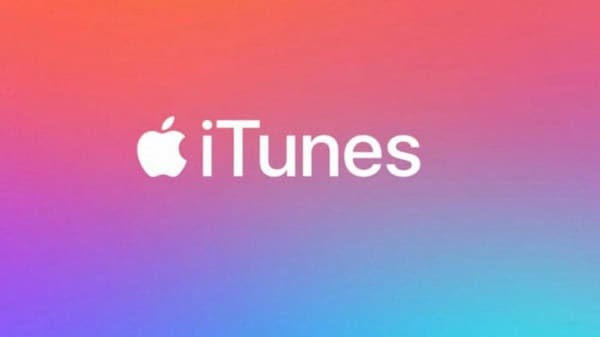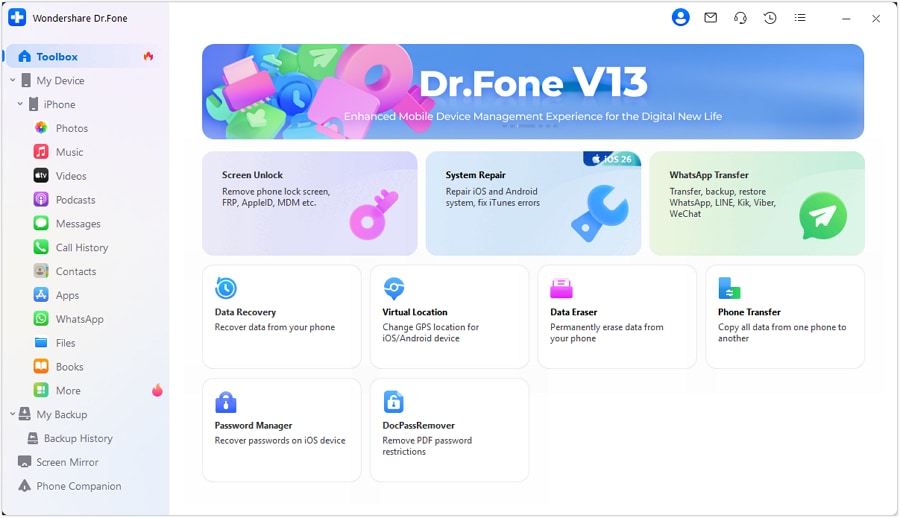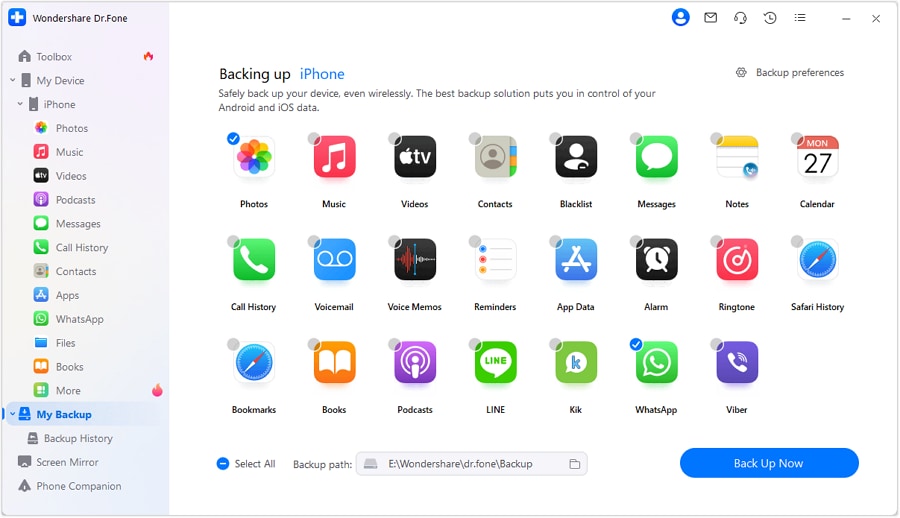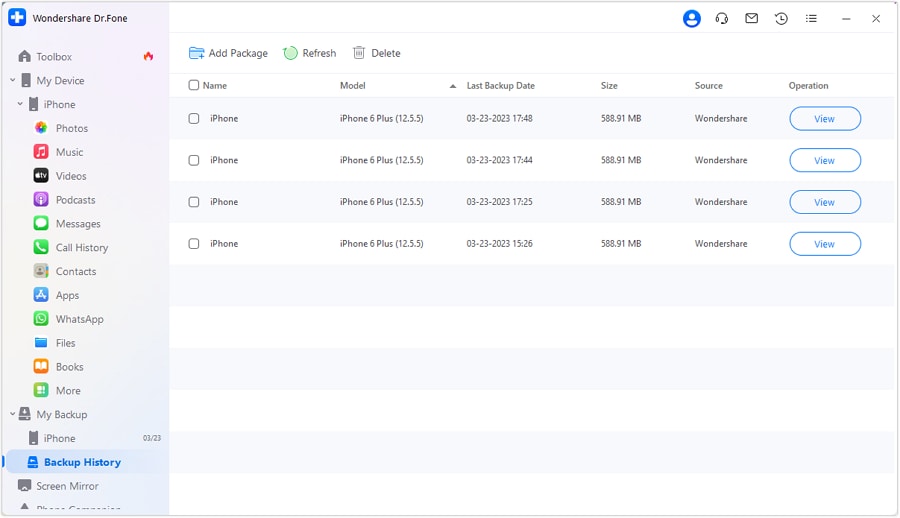
How to Change iTunes Backup Location on Windows 11 & 10 [iPhone 17 Supported]
iTunes Manage
- iTunes Backup
- 1. Does iTunes Backup Photos
- 2. Forgot iTunes Backup Password
- 3. Fix iTunes Corrupt Backup
- 4. Fix iTunes Backup Session Failed
- 5. Change iTunes Backup Location
- 6. View Files on iTunes Backup
- 7. Backup WhatsApp Using iTunes
- 8. Top 5 iTunes Backup Managers
- 9. Top 6 Free iTunes Backup Extractor
- 10. Backup iMessage Without iTunes
- iTunes Restore
- 1. Restore Photos from iTunes Backup
- 2. Restore Data from iTunes Backup
- 3. Restore WhatsApp Using iTunes
- iTunes Rebuild
- 1. Transfer iPad Purchases to iTunes
- 2. Transfer iPad Music to iTunes
- 3. Transfer iPod Music to iTunes
- 4. Transfer Android Music to iTunes
- 5. Import Multiple Lyrics to iTunes
- iTunes Transfer
- 1. Sync iTunes Media to iCloud
- 2. Sync iTunes Media to Android
- 3. Transfer iTunes Music to iPod
- 4. Transfer iTunes Music to Flash Drive
- 5. Transfer iTunes Music to Android
- 6. Transfer iTunes Music to Google Play
- 7. Put iTunes Audiobooks to Android
- 8. Copy iTunes Playlists to Hard Drive
- 9. Move iTunes Library to PC / Mac
- 10. Export iPhone Contacts from iTunes
- 11. Export Playlist from iTunes
- iTunes Plugins/Alternatives
- 1. Top 3 iTunes Plugins
- 2. Top 20 Alternatives to iTunes
- 3. Top 3 iTunes Alternatives for Android
- 4. Top 5 iTunes Remote for Android
- iTunes Problems
- 1. Fix iTunes Error 11
- 2. Fix iTunes Error 1100
- 3. Fix iTunes Error 2005/2003
- 4. Locked Out Of iTunes
- 5. Forgot iTunes Password
- 6. Account Has Been Disabled in iTunes
- iTunes Tricks
- 1. Change the iTunes Skin
- 2. Use File Sharing in iTunes
- 3. Use Home Sharing in iTunes
- 4. Recover iPhone Data from iTunes
- 5. See iTunes Purchase History
- 6. Get Free iTunes Cards Legally
- 7. iTunes Visualizers Download
- 8. Watch iTunes Movie on Android
- 9. Update iTunes On Your Computer
- 10. Install iTunes on Windows / Mac
- ● Manage/transfer/recover data
- ● Unlock screen/activate/FRP lock
- ● Fix most iOS and Android issues
- Manage Now Manage Now Manage Now
Oct 24, 2025 • Filed to: Backup & Restore Solutions • Proven solutions
Dr.Fone Basic:
Better Control for Your Phone
Manage, transfer, back up, restore, and mirror your device
"Where is the iTunes backup location in Windows 11/10? I can't seem to find where the iTunes backup folder in Windows 11/10 is!"
Apple's iTunes is a one-in-all media manager and a playback app for both Mac and Windows. It stores the entire Backup of your iOS device in the primary disk of your Mac and windows.

iTunes remains a widely used option for backing up iPhones—including the latest iPhone 17—on computers running Windows 11 or Windows 10. However, one major limitation is that you cannot directly change the default backup location; iTunes stores all backup files in a fixed system folder on your main drive. As regular backups often occur automatically every time you connect and sync your iPhone, these files can quickly consume many gigabytes of storage.
The space on your Windows partition gets reduced constantly with the ever-expanding iOS backup folder. Further, iTunes does not allow you to change the iTunes backup location windows 11/10. But, there are some tricks with which you can find or change iPhone backup location windows 11/10.
If you are an iTunes user, this article will be useful to you. In this article, we will discuss how to find and change iTunes backup file location windows 11/10.
Part 1- Where is iTunes Backup Location on Window 11/10
By default, iTunes saves all your iPhone backups to a specific “Backup” folder, and the folder’s location varies depending on your operating system, such as Windows 11 or Windows 10. If you’re looking to move iTunes backup location Windows 11/10 or want to know how to iTunes change backup location Windows 11/10, it’s important to proceed carefully.
1.1 Here are a few ways to find the iTunes backup files location on window 11/10:
Find the iTunes backup in the Mobile Sync folder. You can find iTunes backup file location windows 11/10 in the Mobile Sync folder. Steps to find the Mobile Sync folder where iTunes backup is saved in Windows 11/10:
- Go to the Disk C: >> Users >> Your username >> AppData >> Roaming >> Apple Computer >> MobileSync >> Backup
Or
- go to Disk C: >> Users >> Your username >> Apple >> MobileSync >> Backup

1.2 Find iTunes location on Windows 11/10 by using the search box
You can also find the iTunes backup folder Windows 11/10 by using Windows Start Menu's Search box. Following are the steps that you have to follow to find the location on window10
- Open the Start menu in Windows 11/10; you can see a Start button next to the search bar.

- If you downloaded the iTunes from Microsoft Store, then you have to click in the Search bar and enter %appdata%

Or go for %USERPROFILE%, then press Enter or Return.

- Then in the Appdata folder, you have to double-click on the "Apple" folder and then "Apple Computer" and "MobileSync" and finally go to the "Backup" folder. You'll find all your iTunes backup file location in Windows 11/10.
Part 2- How You Can Change the iTunes Backup Location Windows 11/10?
If you own an iPhone—including the latest iPhone 17—and want to iTunes change backup location Windows 11/10, it’s important to understand the correct steps before getting started. The next sections of this guide will walk you through the process of how to move iTunes backup location Windows 11/10 safely and efficiently. But before making any changes, you should also understand why altering the iTunes backup location is so important on Windows 10 or Windows 11—reasons can include freeing up valuable disk space, using a faster SSD, or better managing backups from large devices like the iPhone 17.
2.1 Why you want to change the iTunes backup location Windows 11/10?
iTunes backups are only certain iOS data like app files, settings, and camera roll photos from the iPhone every time you sync. If the iTunes backup gets full, then it affects the ideal performance of your system. Following are some important reasons why you want to change iTunes iPhone backup location Windows 11/10
- Heavy storage on Disk C

iTunes backs up iOS data, including app files, images, videos, settings, and more from the iOS devices each time you sync. Moreover, the iOS backup files may accumulate the storage of your drive very quickly. Due to this, Disk C gets full in less time. This may further lead to a slow Windows Operating System, low storage space for other files, and no space to install new programs
- For your personal reasons
Sometimes due to personal reasons, you may not want others to look into your personal data. In that case, also you can change iTunes backup location Windows 11/10.
- Easy to find iTunes default location
As it is easy to search iTunes in the default location, so if anybody wants to change the location can do so.
2.2 Ways to change the iTunes backup location on window 11/10
If you want to iTunes change backup location Windows 11/10 or fully move iTunes backup location Windows 11/10 to another folder, using a symbolic link (symlink) is an effective solution. A symbolic link allows you to create a virtual connection between iTunes’ default Backup folder and your new preferred storage destination—such as a different partition, external hard drive, or faster SSD. This means all your iPhone backups, including large files from the latest iPhone 17, are safely redirected without disrupting iTunes’ normal operation.
But before doing that, you will need to make a new folder for all your potential backup locations. After this, you can proceed with locating the existing backup locations. Following are the steps you will need to follow to change the iTunes backup location on window 11/10.
- As you have located the current iTunes backup directory, now you have to make a copy of the C: >> Users >> Your username >> AppData >> Roaming >> Apple Computer >> Mobile Sync >> Backup >> directory.
- You have to create a new directory for the data, where you want iTunes to store all your backups from now on. For example- you can create a directory in C:\ folder.
- Then you have to go into the directory that you create by using the "cd" command.

- Now you can navigate to the current backup location by - C: >> Users >> Your username >> AppData >> Roaming >> Apple Computer >> MobileSync >> Backup. Further, using the Windows 11/10 File Explorer can also delete the backup directory and its content.
- Go back to the Command Prompt and then type the same command: mklink /J "%APPDATA%\Apple Computer\MobileSync\Backup" "c:\itunesbackup." Ensure to use the quotes.

- As you have created the symbolic link successfully, you can now connect the two directories and change the iTunes backup locations in Windows 11/10.
- From now all your new iTunes backups are transferred to the "C:\itunesbackup" or the location that you have select.
Part 3- Best Alternative for iTunes to Backup or Restore your Data
Sometimes you may find it difficult to restore your iPhone's data through the computer as iTunes backup cannot be open on PC. It is one of the limitations of Apple phones. But with the help of Dr.Fone-Phone Backup (iOS), you can open the backup file on a PC, and it can also restore to a different phone.
Notes: I can't open iTunes backup on win 11/10; why?
When you locate an iTunes backup file on Windows 11 or 10, you may notice the files are encrypted as long character strings or unreadable names. This means you can’t directly access or read the contents of the backup. Sometimes, if you try to open the iTunes backup location Windows 11/10 or after you move iTunes backup location Windows 11/10, you’ll receive error messages or encounter access issues. Here are some common reasons why iTunes may not open or recognize the backup location:
- Not Enough Space Available on this Computer
- iTunes could Not Recognize your Device
- The Lockdown Folder is Corrupt
- Security Software Conflicting with iTunes
- The device is Not Compatible for Requested Build
To open iTunes and restore the Backup and view the files, you will need to use a professional tool like Dr.Fone-Phone Backup (iOS). It helps to extract data from iTunes backup files or view iTunes backup files on window 11/10.
With Dr.Fone Phone Backup, you can easily open and restore backup files on your PC, even if you’ve used methods to iTunes change backup location Windows 11/10 or move iTunes backup location Windows 11/10. This tool lets you restore all your data to a new phone—including the latest iPhone 17—and also allows you to selectively recover any content from an iCloud Backup to your device, without overwriting your existing information.
Moreover, it helps to back up the iTunes data selectively as well as freely.
Dr.Fone offers an easy way for iTunes Backup on Window 11/10
Download for PCDownload for Mac
4,039,074 people have downloaded it
Dr.Fone - Phone Backup (iOS)
Backup Data Before Installing New iOS Beta Version
- One-click to backup the whole iOS device to your computer.
- Allow previewing and selectively export contacts from iPhone to your computer.
- No data loss on devices during the restoration.
- Works for all iOS devices. Compatible with the latest iOS version.

It is essential for backing up the iPhone data regularly. Dr.Fone offers the easiest and flexible ways to Backup and restores all your data in your iPhone. The best part restores the Dr.Fone data backup and restores all the iTunes and iCloud backup files without affecting any other data.
Let's find out how you find and restore iPhone backup file location Windows 11/10 with the help of Dr.Fone-Phone Backup (iOS).
Step 1: Backup iPhone Data to the system
To start with, launch the Dr.Fone toolkit, open the Phone Backup module, and connect your device. From the provided options, choose to backup your iPhone data.

Now, the application will display an extensive list of various data types that you can save. Here, you can select what you wish to include in the backup or select all files.

That’s it! You can now click on the “Backup” button and wait for a while as the application would back up your data to the computer. When the process is completed, it will let you know to go to the location where your backup is saved and check it.

Step 2: Restore a previous backup to your iPhone
The process for restoring an existing backup to your iOS device is also pretty simple. Once you connect your iPhone and launch the application, select the “Restore” feature from its home.

You can view various options to restore a backup from different sources to your iPhone from the sidebar. Choose to restore Dr.Fone backup files to get a list of the available backup options.

After selecting and loading a backup file, its content would be displayed on the interface under different sections. You can preview the data here, select what you wish to get back, and directly restore it to the connected device.

Conclusion
We hope this article has helped you understand how to find, iTunes change backup location Windows 11/10, and successfully move iTunes backup location Windows 11/10—especially for managing large backups from devices like the new iPhone 17. For a more streamlined and secure backup experience, we recommend using Dr.Fone - Phone Backup (iOS). With powerful features and an easy interface, Dr.Fone lets you manage, back up, and restore your iTunes data effortlessly. Try it now to keep your iPhone 17 and other Apple device backups organized and protected.
Dr.Fone Basic:
Better Control for Your Phone
Manage, transfer, back up, restore, and mirror your device



















Alice MJ
staff Editor